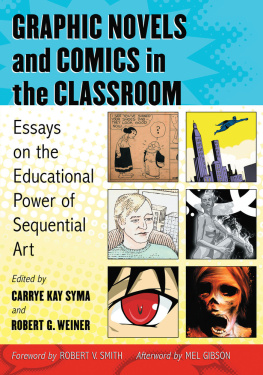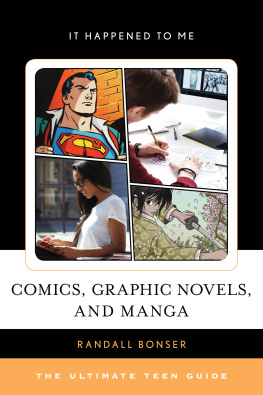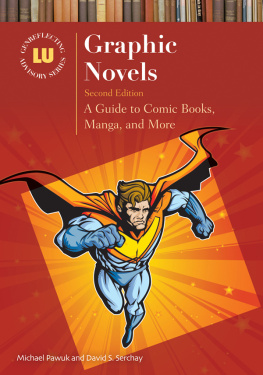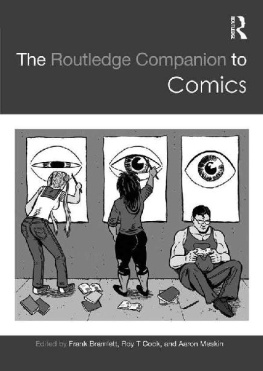
Graphic Novels and Comics in the Classroom
Essays on the Educational Power of Sequential Art
Edited by CARRYE KAY SYMA and ROBERT G. WEINER
Foreword by ROBERT V. SMITH
Afterword by MEL GIBSON

McFarland & Company, Inc., Publishers
Jefferson, North Carolina, and London
LIBRARY OF CONGRESS CATALOGUING DATA ARE AVAILABLE
BRITISH LIBRARY CATALOGUING DATA ARE AVAILABLE
e-ISBN: 978-1-4766-0197-7
2013 Carrye Kay Syma and Robert G. Weiner. All rights reserved
No part of this book may be reproduced or transmitted in any form or by any means, electronic or mechanical, including photocopying or recording, or by any information storage and retrieval system, without permission in writing from the publisher.
Cover illustrationsclockwise from upper left: Thimble Theatre comic strip panel, E.C. Segar, 1921; superhero 2013 Digitalvision; female re spirit 2013 Antonis; zombie 2013 Aaron Rutten; anime eye 2013 Hemera; man in ofce 2013 Dorling Kindersley
McFarland & Company, Inc., Publishers
Box 611, Jefferson, North Carolina 28640
www.mcfarlandpub.com
Acknowledgments
The editors would like to thank Dr. Robert V. Smith and Dr. Mel Gibson for their foreword and afterword. Thank you for taking time out of your busy schedule to take part in this project. It is an honor to work with you both. We would also like to thank all of the reviewers who also took time out of their hectic lives to take a look at these essays. We hope this is a volume of which you can be proud to have contributed.
***
I would like to dedicate this volume to my husband, Jake Syma, and our children, Lella and Jacob. Thank you for being so patient with me and for your continued love and support.
I would also like to thank my colleagues who have aided me throughout this process. A special thanks to all of the authors who contributed to this volume. I would like to thank Kevin Jones for his amazing art work for the graphic short we created. Rob, this project has been interesting, to say the least!
Carrye Kay Syma
***
I would like to dedicate this volume to the memory of my father, Dr. Leonard Weiner, who was at the forefront of the computer revolution (having worked at IMB in the 1960s and helped with founding the Computer Science department at Texas Tech). Your contribution to the world of education and to the community is not forgotten. I remember all those late nights you stayed up grading. You were a true inspiration as an educator. I also dedicate this volume to the memory of my prairie dog Poncho (who warmed my heart). You were my constant companion for nearly eight years and the best pet I ever owned. Thanks to all my other critters still with me especially Sweet Girl, Mr. Eddie, and Blossom. Thanks to Dr. Jessica Thomas, Dr. Jimmy Gleason, Todd Klein, Nick Yanes, Matt Mceniry, and Denise Caspell.
Love and thanks to my mother Marilyn May Weiner (who is also an educator and inspiration), Larry and Vick Weiner, Tom Gonzales, Joe Ferrer, John Oyerbides, and Sara Dulin.
Thanks also to Joe Gulick, Shelley and Ian Barba, the deans of Texas Tech University Libraries, Dean Dyal Laura Heinz (for good advice), my colleagues in RIO (Ms. Cynthia Henry, Ryan Cassidy, Dr. John Hufford, Brian Quinn, [dedication to the memory of Sandy River], Sheila Hoover, Sam Dyal, Esmeralda Rodriguez, Jake Syma, Arlene Paschal, Innocent Awasom, Tom Rohrig, Kimberly Vardman, Minerva Alaniz, Jack Becker, Donell Callender), Mr. Ryan Litsey, Connie Kitten, Dulcinea A., Christiana P., Selena Kyle, Shannon Jones, Kevin Jones, Kaley Daniel, Ms. Amy Kim, Karin Slyker (thanks for your continued support), Eobard Thawne, Norrin Radd, Erik Lehnsherr, Max Eisenhardt, Jim Hammond, Bart Hill, Mark Todd, Doug Campbell, Cord Scott, Lance Eaton, Mr. B. Quinn, Ron Thomas, Richard Graham, Kevin Flanagan, Patrick Grzanka, Liorah A. Golomb, Roberto Delgadilo, Jessica Olin, Alison Mandaville, Karen Gavigan, Gwen Evans, Francisca Goldsmith, Vivian Howard, Arianne Hartsell-Gundy, Phillip Troutman, Miss K. Vardeman, Barbara Mcarthur, and Dr. Rodney Donahue. Thanks to the Document Delivery Staff at TTU, LTMS department, Southwest Collection and all the faculty and staff of TTU Libraries, thanks to Joan Ormrod, David Huxley.
Thanks to John Cline, Susan Hidalgo, Carol Tilley, Lan Dong, Jacqueline Edmondson, Robert Moses Peaslee, Cindy Miller, Amy Nyberg, Elizabeth Figa, James Bucky Carter, and Chris Angel. It is a privilege to work with you.
Thanks to all the authors in this volume for their patience; its been a long time coming.
Lastly, thanks to my co-editor, colleague and friend Carrye Syma for all her hard work. Its been great working with you. Thanks for believing in this project. I hope we do more together!
Robert G. Weiner
Foreword
ROBERT V. SMITH
If you are like me, when you pick up a newly published or newly acquired book, you fan through the pages, stopping here and there to look at the illustrationsbe they diagrams, photographs, or comic images. They all draw us in! But, the comic illustrations often have the greatest impact because they are frequently used to vividly express ideas, emotions, and action in the context of the narrative. You are then presented with the mental invitation to start reading the text and if it is interesting, compelling, and coherent youre hooked.
In this volume, Syma and Weiner provide us with a series of essays describing robust associations among authors and illustrators to produce graphic novels, novelettes, textbooks and other curricula materials. Through the collective works we are offered suggestions that graphic creations have enhanced power to engage and instruct learners of all ages, but perhaps most importantly the visually inspired members of the Millennial generation. Moreover, trends in the use of graphic aids and instruction throughout all walks of life and across many cultures, suggests an increasing, not diminishing, use of graphics in the futureall based on an abundance of scientic studies that support facilitated learning through combinations of image and text.
From a personal perspective, I attest to the power of graphics and specically comic graphics to illustrate and reinforce meaning of the written and spoken word. Beginning in the early 1980s, and in a series of personal and professional books on topics from graduate research in the sciences to management of academic research groups to leadership development of professionals in private and public workspaces, comic illustrations have played key roles. One of the earliest works incorporated previously crafted comics that were adopted through licenses and fees. Another early work used cartoons commissioned by a publisher and crafted by a distant artist that I had little inuence on, except for possible rejection of a cartoon or two.
In my most recent works, beginning in 2004, I have worked on three book projects with the Arkansas illustrator Dusty Higgins. Akin to the landmark association between L. Frank Baum and illustrator W.W. Denslow in the creation of The Wonderful Wizard of Oz, Dusty and I have collaborated in crafting characters and situations that have not only enlivened the resulting book-length works but also served to engage and entertain audiences during hundreds of presentations. Our most recent effort has led to The Way of OzA Guide to Wisdom, Heart, and Courage
Next page








